How to Remove Ticks From Shih Tzu
WRITTEN BY STACY | EVERYTHINGSHIHTZU.COM
This post may contain affiliate links. Read privacy & disclosure policy for info
You may not like the idea of removing a tick from your dog, but it’s important that you know how to do it, and how to do it quickly.
Ticks carry a range of diseases like Lyme disease, Rocky Mountain Spotted Fever, and Tick-Borne Encephalitis, and they infect thousands of animals and people every year.
Since infection can happen as early as three to six hours after your dog is bitten, the sooner you can remove the tick from your pup, the less chance there is of your dog getting sick.
 Remove ticks from dogs
Remove ticks from dogsHere's how to take ticks off your dog:
- Using tweezers grasp the tick close to the skin
- With steady, even pressure pull upwards until tick comes out
- Thoroughly clean the area with soap and water or alcohol
- Dispose of tick in alcohol and flush down the toilet
When removing a tick from your Shih Tzu, it’s critical to use the right tool for the job. You don’t want to risk damaging the tick itself and spreading potential infection.
You can use fine-point tweezers, or a special tool designed specifically for removing ticks like the Tick Stick or Tick Twister.
Never use your fingers as this increases the likelihood of infection, not to mention it is rarely effective.
If the thought of removing ticks off of your dog makes you nervous, don’t worry, it’s not as difficult as it may seem at first.
In fact, once you get the hang of it, it is a rather easy endeavor.
The key element here is that you arm yourself with the knowledge of how to remove ticks correctly, especially if you live in a wooded area or a region where ticks are more prevalent.
Once you know how to safely remove ticks, you’ll be more comfortable with the idea, and your pup will thank you!
Safely Removing Ticks from a Dog?
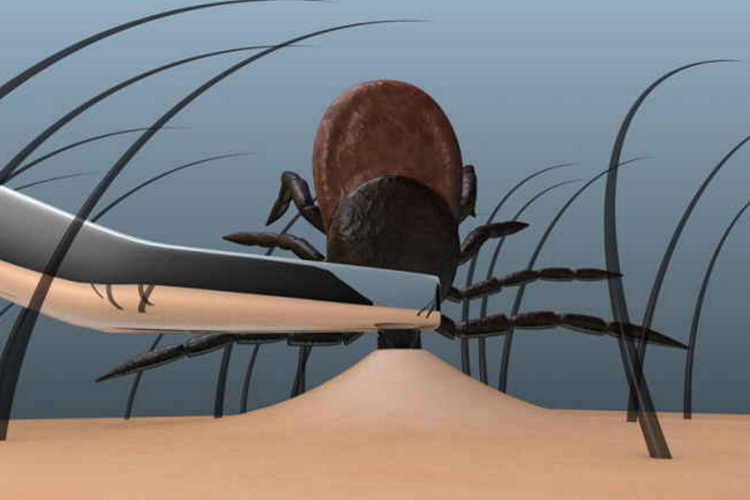 Grab tick closest to the skin
Grab tick closest to the skinFirst things first, if you suspect there is a tick on your dog, you don't need to panic.
All that you will accomplish by panicking is stressing yourself out and freaking out your pup.
Instead, stay calm, grab the appropriate tool and prepare to go tick hunting.
A pair of fine-point tweezers works well.
You might want to keep a pair of these on hand as most household tweezers can have a more blunt tip.
The reason it is so important to use the appropriate tool for the job is you do not want to risk damaging the tick.
This can lead to the potential spread of infection.
You can also use tools specifically designed for removing ticks, but never use your fingers; they're pretty much useless for tick removal.
Once you're armed with the right tool, locate the offender that is trying to feast on your pooch.
Spread your dog's fur so that you can easily spot the tick and then grasp the tick as close to your dog's skin as possible.
Many people are under the false notion that the tick's head embeds under the skin.
However, ticks actually do not have heads; they are completely one body part with "mouthparts," and it is these "mouthparts" that embed in your pup's skin.
Since you don't want any part of the tick to break off in your dog's skin, pull slowly and steadily straight upward away from your dog.
If you find this tricky to do or you live in an area that is prone to ticks, you may want to invest in a special tick removal hook that can make the process even easier.
My personal favorite tool remover is the tick key, but there are several other tools that you may find to your liking.
You can find these tools online or at pet supply stores.
Be sure that you view all areas of your dog's body when checking for ticks, especially in these parts:
- Groin area
- Under armpits
- Between the toes
- Around the tail and backside
- In and around ears
- Eyelids
- Under the collars/harness
Ticks will typically latch on to the warmest parts of the body, so don't be surprised if you find more than one on your dog.
What if Part of a Tick Breaks Off in Your Dog?
When you get the hang of it, removing a tick from your pup gets easier, but what happens if things don't go to plan?
If a piece of the tick (its mouthparts) breaks off in your dog's skin, then your best course of action is to take your dog to the vet.
Sometimes the bits could come out on their own, but there is still a risk of infection.
Whatever you do, do not try and dig the pieces out as this could just make things worse.
Play it safe, and take your furry friend to the vet.
What Do You Do with a Tick Once It’s Removed?
Hooray, you've removed the tick from your dog! Now what?
Well, simply removing the tick doesn't kill it.
To properly dispose of a tick place it in alcohol, put it in a sealed container or wrap it tightly with tape, or there's always the reliable method of flushing it down the toilet.
Warning: If someone tells you to drop a tick on the ground and set it on fire...don't
Once you've properly disposed of your adversary, clean the bite site with rubbing alcohol.
It's also a good idea to clean the tool that you used with a disinfectant, and of course, wash your hands.
If you removed the tick quickly, and also if your pup is on monthly flea and tick prevention, odds are good that your battle is won.
However, if during the days (or even weeks) following the experience you notice changes in your pooch like vomiting, lethargy, a limp, or other differences, don't debate it -- just have your dog checked out by a vet and make sure to mention the tick bite.
After your victory in the tick battle, it's time to shower your canine companion with loving pats and treats.
Treats are always a must.
Common Types of Ticks
Ticks are most closely associated with spiders, thanks to the fact that they feature 8 legs and fall under the classification If Arachnida.
Ticks can be found in almost every part of the world; there are roughly 200 different species of ticks living in the US, and they are survivors.
Here are a few of the most common ticks found around the country.
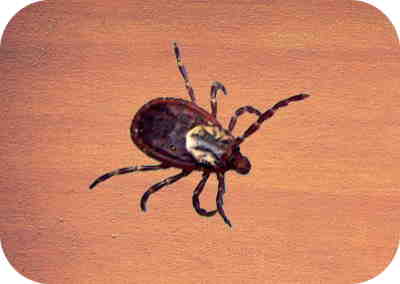 American Dog Tick
American Dog TickThe American dog tick are sometimes called wood ticks. Highest risks of being bitten occurs during the spring and summer
Transmits: Tularemia and Rocky Mountain spotted fever.
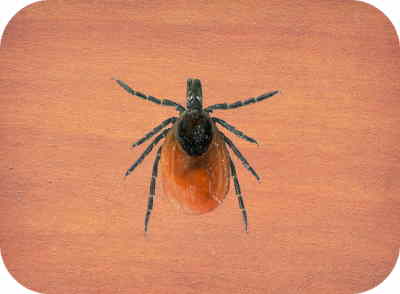 Blacklegged (Deer tick)
Blacklegged (Deer tick)The highest risk of being bitten by a Blacklegged tick also known as a "Deer Tick" is in the spring, summer, and fall. However, adults may be out any time temperatures are above freezing.
Transmits: Borrelia burgdorferi and B. mayonii (causes Lyme disease); Anaplasmosis; Ehrlichiosis; Babesiosis; Powassan virus
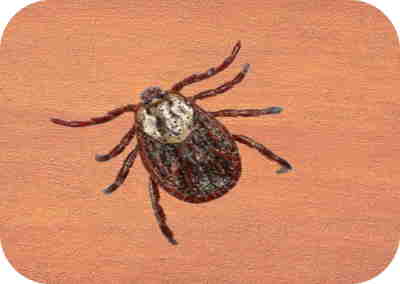 Brown Dog tick
Brown Dog tickThe Brown Dog ticks are particularly fond of feeding on dogs however they may also bite humans or other mammals.
Transmits: Rocky Mountain spotted fever
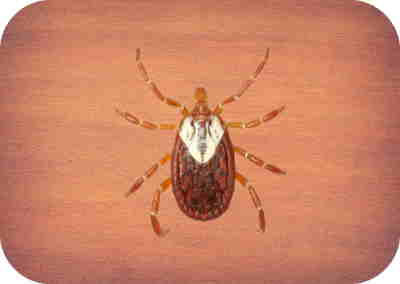 Gulf coast tick
Gulf coast tickThe Gulf coast nymph tick feed on birds and small rodents, while the adults feed on deer and other wildlife.
Transmits: Rickettsia parkeri rickettsiosis, a form of spotted fever
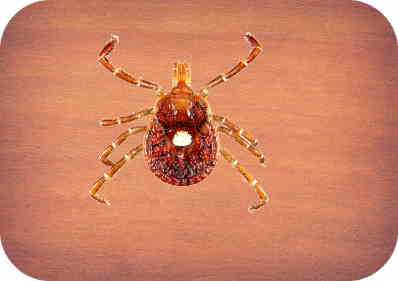 Lone star tick
Lone star tickThe Lone Star tick is very aggressive towards it host. The female has a white dot on her back.
Transmits: Ehrlichia chaffeensis and Ehrlichia ewingii
You can read more about ticks, the regions and diseases they spread by searching the CDC website.
 Ticks like tall grass
Ticks like tall grassTicks can withstand a diverse array of climates, and even though they are most often found in wooded areas like forests, they also are perfectly content to hang around in a variety of other locations like lawns and yes, even urban areas.
Here's a fun fact; ticks only breed when they're feeding so needless to say, they have a strong desire to feed a lot.
Plus, they aren't picky when it comes to their food, so pretty much anything is fair game.
Your precious pup enjoying outdoor playtime, or a leisurely walk looks like a smorgasbord to hungry ticks.
Keep in mind, a tick is not the same as a flea.
Unlike fleas who can hop onto their host, a tick cannot jump.
Therefore, ticks lie in wait in grass or bushes, keeping their eyes out for a potential host.
When your sweet furry pal rambles by, a tick simply latches on with its mouthparts and holds on tight with the help of a sticky substance that it secretes.
Depending on where you are, ticks can be many or few.
A female can lay up to 3,000 eggs, but there are a few species of tick that lay closer to 20,000!
That means that your poor pooch is probably out-numbered, even if you can't see any ticks around -- some are almost impossible to see, while others can be the size of your fingertip.
So be diligent when it comes to check your Shih Tzu for ticks, especially when they have been outside!



